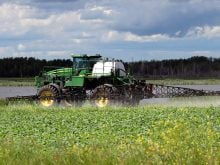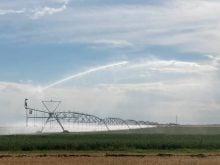Seeding isn’t the only farming operation hampered by the soggy spring. Farmers are being advised to monitor their emerging crops to see if the rain has nullified the fertilizer they applied.A soil expert says growers should expect decreased fertilizer efficiency in waterlogged portions of the Prairies.”The kind of conditions that we’ve got this spring are certainly conducive to some losses, especially of nitrogen, that we wouldn’t normally see,” said Jeff Schoenau, a professor in the University of Saskatchewan’s department of soil science.Severity of the nutrient loss depends on a number of factors, including seeding dates, the amount of rainfall received and the type of fertilizer used. But it’s a big enough concern that Schoenau is advising producers to keep a close eye on their crops.”A visual inspection is a first good indicator,” said Schoenau.One telltale sign of nutrient deficiency is a yellowing of crops but that could also be due to other factors like disease infestation. If a grower suspects his crop is suffering from a lack of nutrients, he should send a tissue sample to a qualified lab for analysis.”If you find your (nutrient) concentration is below the critical level, then you could maybe go out and top dress on some fertilizer,” he said.The problem shouldn’t be ignored.”If it’s deficient and you don’t do anything about it, the yield penalty can be pretty severe.”Schoenau said it is important to identify and address the problem as soon as possible. Cereals can have good yield recovery if top-dressed at or before the tillering stage of development. The situation isn’t as pressing for canola crops, which can rebound by broadcasting sulfate right up until the time of flowering.Nutrient loss during periods of heavy rainfall is primarily an issue for nitrogen fertilizers and sulfur. Phosphorus and potassium fertilizers are not nearly as susceptible.The loss occurs after the nitrogen has been converted into nitrate. The nitrate can be carried with water percolating down through sandy soils until it is below the root system and unavailable to the plants. For clay soils, the nitrate can make its way into pools of water lying on the field and be converted into nitrogen gas that is lost to the atmosphere.Farmers who applied slow release nitrogen fertilizers like coated urea or who used additives like nitrification inhibitors will be reaping the rewards this year.”They can work really quite well to reduce nitrogen losses under these very wet conditions,” said Schoenau.Growers who discover their crops are nutrient deficient could be confronted by a tough agronomic decision. Those who planted later than usual may decide it is not worthwhile to spend money fertilizing a crop that will be more susceptible than normal to fall frost damage, he said.
Read Also

New fertilizer product aims to reduce tie-up, improve soil health
A new phosphorus fertilizer, launched at Ag in Motion 2025, promises to reduce nutrient tie-up and deliver slow-release feeding throughout the growing season.















